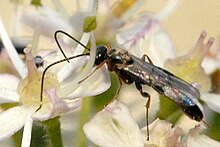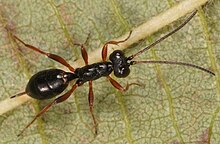Cryptinae
| Cryptinae | ||||||||||||
|---|---|---|---|---|---|---|---|---|---|---|---|---|

Endasys parviventris , tribe Gelini |
||||||||||||
| Systematics | ||||||||||||
|
||||||||||||
| Scientific name | ||||||||||||
| Cryptinae | ||||||||||||
| Kirby , 1837 |
Cryptinae is the largest subfamily of parasitic wasps with around 4,500 species in 408 genera. It is spread all over the world. It is sometimes also called Gelinae or Phygadeuontinae .
morphology
The Cryptinae are small to medium-sized parasitic wasps, which are mostly winged (forewings 2 - 27 mm long), there are also wingless species. Cryptinae have a distinct ovipositor that can be short or long. In the fore wing is a more or less pentagonal cell. They are often black, reddish or brown in color, in the tropics they can also be relatively colorful and large. Cryptinae have a round face with a convex clypeus. On the side of the thorax there is a clear horizontal line on the mesopleuron (middle part of the thorax side ), the sternum . The abdomen is flattened, the first segment is narrow at the base and then widens. Most of the males have tyloids (elongated, raised sensory fields) on individual antenna segments.
The ovipositor can be found in those species that only lay their eggs in free-living host larvae for a short time, while other species whose hosts live in wood, stems or in soil nests often have conspicuously long ovens.
A clear diagnosis is difficult due to the large number of species and the many homoplasias of the characteristics. They are very similar to the Ichneumoninae. Due to the large number of closely related species, the identification of the individual species is usually only possible for specialists.
Way of life
All Cryptinae are parasitoids , the hosts of which are mostly pupae or prepupa (mature larvae) of holometabolic insects. Butterflies are very often parasitized, but also other Hymenoptera , beetles and dipteras . Also cocoon-like egg sacs from spiders and egg nests from pseudoscorpions can serve for the development of the Cryptinae. The host range is extremely diverse, but the individual species are often very host-specific. Some species are endoparasitic . One type of Apsilops was bred from cocoons of the semi- aquatic butterfly Nymphula ( Pyralidae ).
Systematics
The systematic-phylogenetic position of the Cryptinae within the Ichneumonidae is not clear. In any case, the two large subfamilies Icheneumoninae and Cryptinae are closely related, they are (with other groups) placed in an informal group "Ichneumoniformes".
The Cryptinae are divided into three tribes , the Cryptini (= Mesostenini) with 250 genera, the Gelini (= Phygadeuontini) with approx. 130 genera and the Hemigasterini (= Hemigastrini) with 26 genera. All three tribes are widespread worldwide, the Hemigasterini have their Schwepunt in the Holarctic, the Gelini are predominant in temperate zones, the Cryptini are especially widespread in the tropics with many species and individuals and there are also many large, colorful species.
Santos divides the subfamily into only two tribes, the Aptesini with 24 genera and the Cryptini with 250 genera. The Ateleutinae, which were previously counted among the Cryptinae, should be viewed as a separate subfamily. The Phygadeuontini are polyphyletic according to Santos, a part of them should be considered a separate subfamily.
According to Sawoniewicz (and other authors) the tribe Aptesini contains 19 genera but without the genus Hemigaster , so it is essentially synonymous with Hemigasterini.
The division of the Cryptini and Gelini into sub-tribes is not uniform. The traditional structure according to Townes has been adopted by many authors, even if it is often not based on phylogenetics. However, it has not been confirmed by recent studies.
Native tribes and genera
In the following indigenous genera are listed according to Horstmann's system (according to, also host information, not complete).
-
Cryptini (= Mesostenini); Tribes with most of the native species, the parasitic wasps are looking for their hosts i. d. R. in the vegetation. Most species develop in butterflycocoons, some also in plant wasp cocoons.
- Agrothereutes (develop in plant wasp cocoons)
- Aritranis (live on adult bee larvae, consume several larvae in adjacent cells)
- Buathra
- Cryptus (develop in butterfly cocoons )
- Enclisis
- Demopheles (looking cocoon of solo activities aculeata in fauem wood or in transitions from xylophagous insects)
- Gambrus (develop in plant wasp cocoons)
- Hidryta (develop in ant lion cocoons)
- Hoplocryptus (develop in bee or wasp nests)
- Idiolispa (develop in ant lion cocoons)
- Ischnus (develop in butterfly cocoons )
- Latibulus (develop in bee or wasp nests, see e.g. Latibulus argiolus )
- Mesostenus (develop in butterfly cocoons )
- Trychosis (develop in ant lion cocoons)
-
Hemigasterini (= Hemigastrini); The adult parasitic wasps often visit flowers to ingest nectar and pollen. For most species, the host search takes place on the ground and in bark. Many species parasitize on wasps.
- Aptesis (develop in plant wasp cocoons, individual species develop in the last larval stage of butterflies)
- Cubocephalus (develop in plant wasp cocoons in plant tissue)
- Giraudia (develop in plant wasp cocoons)
- Oresbius (develop in plant wasp cocoons)
- Pleolophus (develop in plant wasp cocoons in the earth)
- Polytribax (parasitoids in butterfly pupae that do not have a cocoon. Exceptionally also hyperparasitoids ).
- Schenkia (parasitoids in butterfly pupae)
-
Gelini (= Phygadeuontini); The hosts are mainly visited on and in the ground. Many species are flightless, they have no or short wings. Gelini pierce small insect cocoons. They also form secondary parasitoids in cocoons of ichneumonids and braconids.
- Aclastus (developing in cocoons of spider eggs)
- Acrolyta (development in cocoons of Ichneumonidae and Braconidae)
- Atracodes (development in pupae of Diptera)
- Bathythrix
- Ceratophygadeuon
- Charitopes (development in cocoons of day people )
- Dichrogaster (development in cocoons of lacewings)
- Endasys (development in cocoons of plant wasps )
- Gelis (mostly wingless, or with shorter wings, partly in habit similar to ants, some species develop in cocoons of lacewing , sawflies, Psychidae ornaments, Coleophoridae B. and in cocoons of spiders eggs. See, Gelis areator )
- Gnotus
- Isadelphus (partly developed in cocoons of Coleophoridae, Ichneumonidae and Braconidae)
- Mastrus (partly development in cocoons of Coleophoridae)
- Medophron
- Mesoleptus (development in pupae of Diptera)
- Phygadeuon (very species-rich, very difficult to determine, development as ectoparasites on the pupae of Diptera)
- Rhembobius
- Stilpnus (development in pupae of Diptera)
- Thaumatogelis
- Theroscopus
Individual evidence
- ↑ a b c d e f B. F. Santos: Phylogeny and reclassification of Cryptini (Hymenoptera, Ichneumonidae, Cryptinae), with implications for ichneumonid higher-level classification . In: Systematic Entomology . tape 42 , no. 4 , 2017, p. 1-27 , doi : 10.1111 / syen.12238 .
- ↑ BugGuide. Iowa State University, 2006, accessed June 7, 2020 .
- ↑ Cryptinae. Retrieved June 7, 2020 .
- ^ A b H. Goulet & JT Huber: Hymenoptera of the World: An identification guide to families . Ottawa 1993, ISBN 0-660-14933-8 , pp. 439 .
- ^ A b c d e K. Schmidt & F. Zmudzinski: Contributions to the knowledge of the Baden parasitic wasp fauna (Hymenoptera, Ichneumonide). 6. Subfamily Cryptinae . In: carolinea . tape 65 . Karlsruhe 2007, p. 189-224 .
- ↑ Andrew MR Bennett, Sophie Cardinal, Ian D. Gauld, David B. Wahl: Phylogeny of the subfamilies of Ichneumonidae (Hymenoptera) . In: J. Hymenoptera Res. Band 71 , 2019, p. 1–156 , doi : 10.3897 / year 71.32375 .
- ↑ a b c d e Janusz Sawoniewicz: Hosts of the world Aptesini (Hymenoptera, Ichneumonidae, Cryptinae) . Wydawnictwo Mantis, Olsztyn 2008, ISBN 978-83-926182-3-2 , p. 150 .
- ^ H. Townes: The genera of Ichneumonidae . In: Mem. Amer. Inst. Part 2. Ann Arbor, Michigan 1970, p. 1-537 .
- ↑ Nina M. Laurenne, Gavin R. Broad, Donald LJ Quicke: Direct optimization and multiple alignment of 28S D2 – D3 rDNA sequences: problems with indels on the way to a molecular phylogeny of the cryptine ichneumon wasps (Insecta: Hymenoptera) . In: Cladistics . tape 22 , 2006, p. 442-473 ( wiley.com [PDF]).
- ↑ K. Horstmann: Ichneumonidae . In: H. Dathe, A. Taeger, SM Blank (ed.): Directory of the Hymenoptera of Germany (Entomofauna Germanica 4), Ent. Message Ber. tape 7 , 2001, p. 69-103 .
- ^ I. Gauld & B. Bolton: The Hymenoptera . Oxford Univ. Press, 1988, ISBN 0-19-858521-7 , pp. 202 f .





